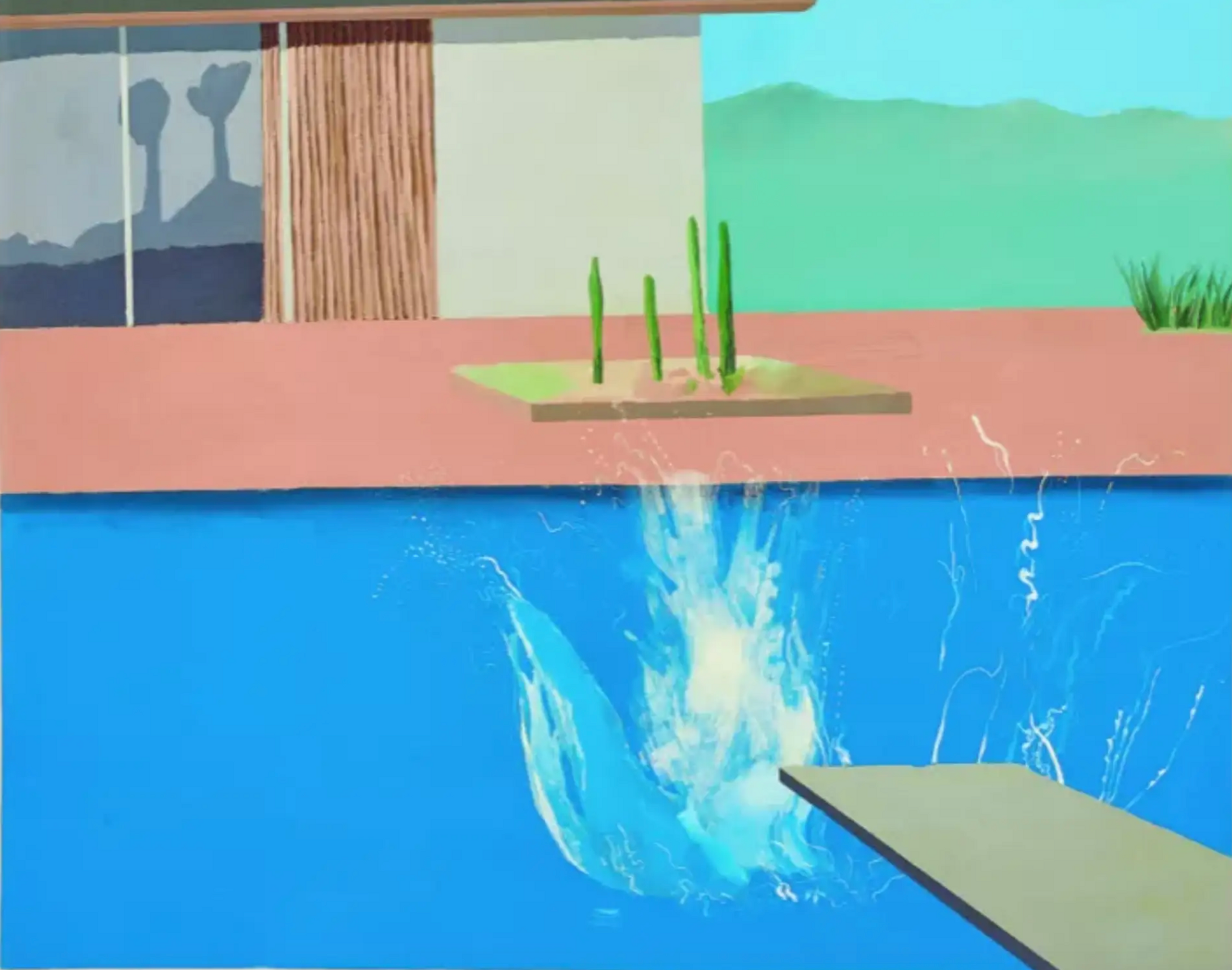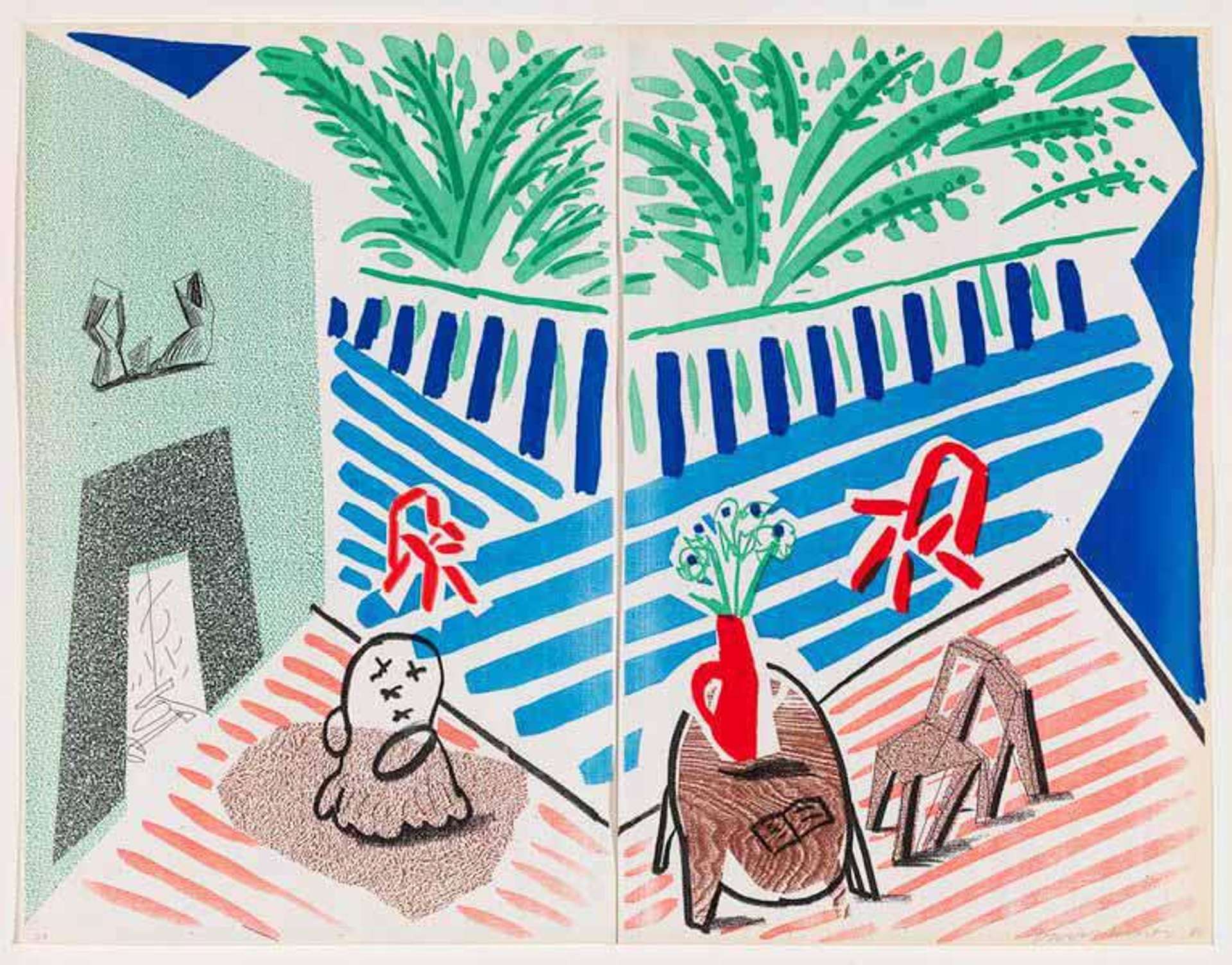David Hockney's Splash: The Californian Pool Paintings
 Image © Sotheby's / The Splash (detail) © David Hockney 1966
Image © Sotheby's / The Splash (detail) © David Hockney 1966 
David Hockney
651 works
British artist David Hockney made a splash in the '60s and '70s with his brightly coloured artworks. This period also saw the artist return time and again to an important symbol of wealth, relaxation, sexual liberation, and Californian exuberance: the Swimming Pool. This article deep dives into the development of Hockney's swimming pool paintings. Product of his life-changing move, in 1964, from drab and dreary London to the searing sun of California, Hockney’s interest in the swimming pool birthed his iconic Splash series, and has since become synonymous with his bright, colourful, and unmistakable œuvre.
London to California: The Splash
Following the success of his first London exhibition, Paintings with People In, held at the Kasmin Gallery in New Bond Street, Hockney sold his piece A Rake’s Progress (1963) – a contemporary re-working of Hogarth’s series of the same name – for a remarkable sale price of £435,482 (including fees) in 2023, making it Hockney's highest-selling print of the year.
With his pockets lined, Hockney was keen to move away from the English capital. Drawn by the glamour of Hollywood, and having had enough of post-war London — a grey, boring place where one needed ‘too much money’ to survive comfortably (drinks cost up to £1, as the artist once remarked in interview) — Hockney moved his home and studio to Santa Monica, California in 1964.
A relocation he likened to that made by Van Gogh in 1888, from Paris to Arles in southern France, the States brought more than just cheap drinks.
The balmy weather granted Hockney a fresh colour palette, and the non-stop sunlight plenty of fresh perspectives: what Hockney calls different ‘ways of seeing’. Most importantly, however, in the ‘60s Californian bohemianism had reached new heights.
Whilst homosexuality was still illegal in the UK, the sexually liberated ‘Golden State’ was home to a thriving gay community that counted the likes of Christopher Isherwood and Don Bachardy in its number. Allowing Hockney the freedom to express his sexuality openly, California marked a turning point in the artist’s life.
Gay print culture, produced mostly in Los Angeles, provided Hockney with a wealth of imagery for his first overt artistic explorations of a theme still taboo in the UK at the time: gay love. Works such as Domestic Scene (1963) and Cleanliness Is Next To Godliness (1964), for example, take their inspiration from photographs published in the magazine Physique Pictorial – the likes of which would have been difficult to find in London. These forthright, true-to-life pieces contrast with the coded, cartoon-like approach characteristic of Hockney’s ‘Love’ paintings, produced whilst he was still a student at the Royal College of Art.
Upon his arrival, Hockney sent a postcard complete with the slogan ‘Greetings from California: ‘Playground of the Nation’ to a friend. It was complete with the words:
 Image © Christie's / Domestic Scene © David Hockney 1963
Image © Christie's / Domestic Scene © David Hockney 1963David Hockney's The Splash Trio
Completed in 1966 and 1967, The Splash series is perhaps the most iconic feature of Hockney’s œuvre.
Forming a dynamic sequence, The Little Splash (1966), The Splash (1966), and A Bigger Splash (1967) all portray the same subject matter – the dramatic moment just after a diver has jumped into a swimming pool, throwing up a large ‘splash’ of water.
The original image featured on the front page of a manual on swimming pool maintenance. A Bigger Splash now belongs in the Tate collection.
With each painting, Hockney gradually abstracts the composition, removing figures and other ornamental features, such as plants and furniture, and elongating the modernist building that stands alongside the pool.
Hockney also crops the scene, with A Bigger Splash forming a square composition reminiscent of a photograph taken with a Polaroid camera: a technology Hockney first discovered in the US that would inspire his Composite Polaroid (1982) and Photo Collage series (1983).
 Image © Sotheby's / The Splash © David Hockney 1966
Image © Sotheby's / The Splash © David Hockney 1966 Image © Tate / A Bigger Splash © David Hockney 1967
Image © Tate / A Bigger Splash © David Hockney 1967One of the most striking features of The Splash paintings is their visible sense of modernity. These images simply don’t ‘get old’.
Perhaps the main reason behind this is that these works were the first to commit the newly-built LA landscape to painting.
Hockney explains: ‘There were no paintings of Los Angeles. People then didn’t even know what it looked like. And when I was there, they were still finishing up some of the freeways. I remember seeing, within the first week, a ramp of freeway going into the air, and I suddenly thought: ‘My God, this place needs its Piranesi; Los Angeles could have a Piranesi, so here I am!’
Another reason behind the paintings’ appeal is their realistic treatment of water. Hockney spent exactly 7 days to capture a realist view of the ‘splash’ itself, using small brushes and delicate strokes to great effect.
As for the swimming pool surface, water is striking for its lifelike fluidity.
This effect was achieved with a mixture of very diluted acrylic paint and detergent. When you paint with this mixture, Hockney argues, the canvas ‘soaks it up like blotting paper’.
 Image © Sotheby's / Picture of a Hollywood Swimming Pool © David Hockney 1965
Image © Sotheby's / Picture of a Hollywood Swimming Pool © David Hockney 1965Other Californian Pool Paintings
The first pool painting made by Hockney upon his arrival in California was entitled California Art Collector (1964). A small depiction of a swimming pool appears to the top left of its composition, signalling the beginning of Hockney’s longstanding obsession with this americana emblem.
Since ’64, Hockney has produced countless other ‘pool paintings’, including Picture of a Hollywood Swimming Pool (1964) and Portrait of Nick Wilder (1966).
Later in his career, Hockney’s love of the pool took him to the south of France, where he took the photographs that would inform the world-famous Portrait Of An Artist (Pool With Two Figures) (1972).
Many hail this piece as a symbolic representation of the artist’s breakup with his partner and fellow artist, Peter Schlesinger.
Other pool works include Water Pouring Into Swimming Pool, Santa Monica (1964), Peter Getting Out Of Nick’s Pool (1966), Lithograph Water Made Of Lines And Crayon (Pool 11-B) (1978), Afternoon Swimming (1980), Lithograph Of Water Made Of Thick And Thin Lines, A Green Wash, A Light Blue Wash, And A Dark Blue Wash (1980), and My Pool And Terrace (1983).
Record Price for a Pool Painting
Who could forget the historical sale of Hockney's Portrait of an Artist (Pool with Two Figures) in 2018? A seminal work in Hockney's career, the painting sold at Christie's for $90.3 million with fees, making him the most expensive living artist at the time, briefly overtaking Jeff Koons.
How much did David Hockney's Splash sell for?
In 2020, the landmark painting The Splash went under the hammer at Sotheby’s in London, realising an astonishing £23.1 million – more than 8 times its previous sale price, realised in 2006.
Since its completion in 1966, The Splash – which had been in private ownership – has become known all over the world.
In the eyes of many, the painting is a 20th-century icon that has played an instrumental role in establishing the visual identity of Los Angeles – an expansive city which, as Hockney tells us, is home to much more than just the Hollywood sign.
Browse our David Hockney prints for sale or get a valuation here.








